 W
WAgglomerate is a coarse accumulation of large blocks of volcanic material that contains at least 75% bombs. Volcanic bombs differ from volcanic blocks in that their shape records fluidal surfaces: they may, for example, have ropy, cauliform, scoriaceous, or folded, chilled margins and spindle, spatter, ribbon, ragged, or amoeboid shapes. Globular masses of lava may have been shot from the crater at a time when partly molten lava was exposed, and was frequently shattered by sudden outbursts of steam. These bombs were viscous at the moment of ejection and by rotation in the air acquired their shape. They are commonly 1 to 2 feet in diameter, but specimens as large as 12 feet (3.7 m) have been observed. There is less variety in their composition at any one volcanic centre than in the case of the lithic blocks, and their composition indicates the type of magma being erupted.
 W
WAmygdules or amygdales form when the gas bubbles or vesicles in volcanic lava are infilled with a secondary mineral such as calcite, quartz, chlorite or one of the zeolites. Amygdules usually form after the rock has been emplaced, and are often associated with low-temperature alteration. Amygdules may often be concentrically zoned. Rocks containing amygdules can be described as amygdaloidal.
 W
WAphanite, or aphanitic as an adjective, is a name given to certain igneous rocks that are so fine-grained that their component mineral crystals are not detectable by the unaided eye. This geological texture results from rapid cooling in volcanic or hypabyssal environments. As a rule, the texture of these rocks is not the same as that of volcanic glass, with volcanic glass being non-crystalline (amorphous), and having a glass-like appearance.
 W
WA breccia pipe, also referred to as a chimney, is a mass of breccia, often in an irregular and cylindrical shape.
 W
WThe Central Atlantic magmatic province (CAMP) is the Earth's largest continental large igneous province, covering an area of roughly 11 million km2. It is composed mainly of basalt that formed before Pangaea broke up in the Mesozoic Era, near the end of the Triassic and the beginning of the Jurassic periods. The subsequent breakup of Pangaea created the Atlantic Ocean, but the massive igneous upwelling provided a legacy of basaltic dikes, sills, and lavas now spread over a vast area around the present central North Atlantic Ocean, including large deposits in northwest Africa, southwest Europe, as well as northeast South and southeast North America. The name and CAMP acronym were proposed by Andrea Marzoli and adopted at a symposium held at the 1999 Spring Meeting of the American Geophysical Union.
 W
WA crystal mush is magma that contains a significant amount of crystals suspended in the liquid phase (melt). As the crystal fraction makes up less than half of the volume, there is no rigid large-scale three-dimensional network as in solids. As such, their rheological behavior mirrors that of absolute liquids. Within a single crystal mush, there is grading to a higher solid fraction towards the margins of the pluton while the liquid fraction increases towards the uppermost portions, forming a liquid lens at the top. Furthermore, depending on depth of placement crystal mushes are likely to contain a larger portion of crystals at greater depth in the crust than at shallower depth, as melting occurs from the adiabatic decompression of the magma as it rises, this is particularly the case for mid-oceanic ridges.
 W
WCumulate rocks are igneous rocks formed by the accumulation of crystals from a magma either by settling or floating. Cumulate rocks are named according to their texture; cumulate texture is diagnostic of the conditions of formation of this group of igneous rocks. Cumulates can be deposited on top of other older cumulates of different composition and colour, typically giving the cumulate rock a layered or banded appearance.
 W
WEssexite, also called nepheline monzogabbro, is a dark gray or black holocrystalline plutonic igneous rock. Its name is derived from the type locality in Essex County, Massachusetts, in the United States.
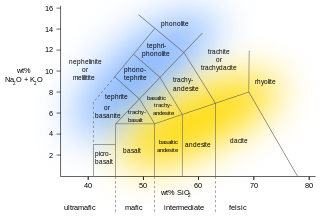 W
WExtrusive rock refers to the mode of igneous volcanic rock formation in which hot magma from inside the Earth flows out (extrudes) onto the surface as lava or explodes violently into the atmosphere to fall back as pyroclastics or tuff. In contrast, intrusive rock refers to rocks formed by magma which cools below the surface.
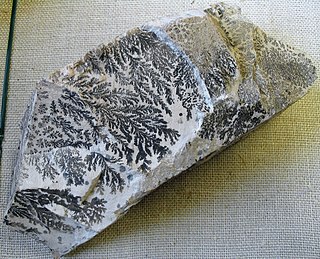 W
WFelsite is a very fine-grained volcanic rock that may or may not contain larger crystals. Felsite is a field term for a light-colored rock that typically requires petrographic examination or chemical analysis for more precise definition. Color is generally white through light gray, or red to tan and may include any color except dark gray, green or black. The mass of the rock consists of a fine-grained matrix of felsic materials, particularly quartz, sodium and potassium feldspar, and may be termed a quartz felsite or quartz porphyry if the quartz phenocrysts are present. This rock is typically of extrusive origin, formed by compaction of fine volcanic ash, and may be found in association with obsidian and rhyolite. In some cases, it is sufficiently fine-grained for use in making stone tools. Its fine texture and felsic components allow for good knapped pieces, much like working chert, producing conchoidal fracture.
 W
WFlow banding is a geological term to describe bands or layers that can sometimes be seen in rock that formed from magma.
 W
WFractional crystallization, or crystal fractionation, is one of the most important geochemical and physical processes operating within crust and mantle of a rocky planetary body, such as the Earth. It is important in the formation of igneous rocks because it is one of the main processes of magmatic differentiation. Fractional crystallization is also important in the formation of sedimentary evaporite rocks.
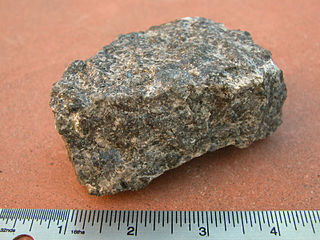 W
WGabbro is a phaneritic (coarse-grained), mafic intrusive igneous rock formed from the slow cooling of magnesium-rich and iron-rich magma into a holocrystalline mass deep beneath the Earth's surface. Slow-cooling, coarse-grained gabbro is chemically equivalent to rapid-cooling, fine-grained basalt. Much of the Earth's oceanic crust is made of gabbro, formed at mid-ocean ridges. Gabbro is also found as plutons associated with continental volcanism. Due to its variant nature, the term "gabbro" may be applied loosely to a wide range of intrusive rocks, many of which are merely "gabbroic".
 W
WGranite Mountain is an igneous intrusion southeast of Little Rock, Arkansas. Despite being named after granite, the rock at Granite Mountain is actually syenite, a rock that is visually similar to granite, but contains much less quartz. The rock was formed in the Cretaceous period around 90 million years ago, after the lamproites at Prairie Creek and the later Magnet Cove complex, and before the formation of the Monroe Uplift and Jackson Dome.
 W
WGranophyre is a subvolcanic rock that contains quartz and alkali feldspar in characteristic angular intergrowths such as those in the accompanying image.
 W
WHornblendite is a plutonic rock consisting mainly of the amphibole hornblende. Hornblende-rich ultramafic rocks are rare and when hornblende is the dominant mineral phase they are classified as hornblendites with qualifiers such as garnet hornblendite identifying a second abundant contained mineral.
 W
WIn geology, an igneous intrusion is a body of intrusive igneous rock that forms by crystallization of magma slowly cooling below the surface of the Earth. Intrusions have a wide variety of forms and compositions, illustrated by examples like the Palisades Sill of New York and New Jersey; the Henry Mountains of Utah; the Bushveld Igneous Complex of South Africa; Shiprock in New Mexico; the Ardnamurchan intrusion in Scotland; and the Sierra Nevada Batholith of California.
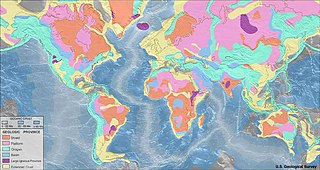 W
WIgneous rock, or magmatic rock, is one of the three main rock types, the others being sedimentary and metamorphic. Igneous rock is formed through the cooling and solidification of magma or lava. The magma can be derived from partial melts of existing rocks in either a planet's mantle or crust. Typically, the melting is caused by one or more of three processes: an increase in temperature, a decrease in pressure, or a change in composition. Solidification into rock occurs either below the surface as intrusive rocks or on the surface as extrusive rocks. Igneous rock may form with crystallization to form granular, crystalline rocks, or without crystallization to form natural glasses. Igneous rocks occur in a wide range of geological settings: shields, platforms, orogens, basins, large igneous provinces, extended crust and oceanic crust.
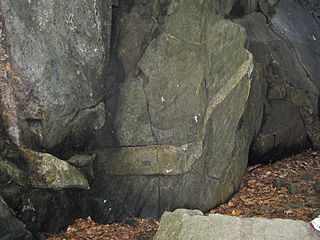 W
WAn intrusive suite is a group of plutons related in time and space. All rocks in an intrusive suite result from the same magma-producing event.
 W
WKenyte is a variety of porphyritic phonolite or trachyte with rhomb shaped phenocrysts of anorthoclase with variable olivine and augite in a glassy matrix. It was originally described and named by J. W. Gregory in 1900 for the occurrence on Mount Kenya. Kenyte has also been reported from Mount Kilimanjaro and Mount Erebus in Antarctica.
 W
WKomatiite is a type of ultramafic mantle-derived volcanic rock defined as having crystallised from a lava with ≥ 18 wt% MgO. Komatiites have low silicon, potassium and aluminium, and high to extremely high magnesium content. Komatiite was named for its type locality along the Komati River in South Africa, and frequently displays spinifex texture composed of large dendritic plates of olivine and pyroxene.
 W
WLamproite is an ultrapotassic mantle-derived volcanic or subvolcanic rock. It has low CaO, Al2O3, Na2O, high K2O/Al2O3, a relatively high MgO content and extreme enrichment in incompatible elements.
 W
WLamprophyres are uncommon, small volume ultrapotassic igneous rocks primarily occurring as dikes, lopoliths, laccoliths, stocks and small intrusions. They are alkaline silica-undersaturated mafic or ultramafic rocks with high magnesium oxide, >3% potassium oxide, high sodium oxide and high nickel and chromium.
 W
WA layered intrusion is a large sill-like body of igneous rock which exhibits vertical layering or differences in composition and texture. These intrusions can be many kilometres in area covering from around 100 km2 (39 sq mi) to over 50,000 km2 (19,000 sq mi) and several hundred metres to over one kilometre (3,300 ft) in thickness. While most layered intrusions are Archean to Proterozoic in age, they may be any age such as the Cenozoic Skaergaard intrusion of east Greenland or the Rum layered intrusion in Scotland. Although most are ultramafic to mafic in composition, the Ilimaussaq intrusive complex of Greenland is an alkalic intrusion.
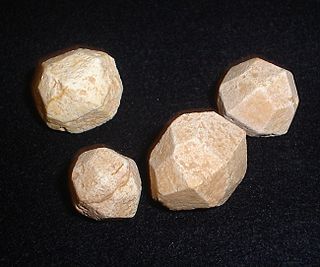 W
WLeucitite or leucite rock is an igneous rock containing leucite. It is scarce, many countries such as England being entirely without them. However, they are of wide distribution, occurring in every quarter of the globe. Taken collectively, they exhibit a considerable variety of types and are of great interest petrographically. For the presence of this mineral it is necessary that the silica percentage of the rock should be low, since leucite is incompatible with free quartz and reacts with it to form potassium feldspar. Because it weathers rapidly, leucite is most common in lavas of recent and Tertiary age, which have a fair amount of potassium, or at any rate have potassium equal to or greater than sodium; if sodium is abundant nepheline occurs rather than leucite.
 W
WIn petrology, limburgite is a dark-colored volcanic rock resembling basalt in appearance, but containing normally no feldspar. The name derives from the type locality the Limberg or the Limburg, close to Sasbach am Kaiserstuhl in Baden-Württemberg, where they occur in the well-known rock of the Kaiserstuhl. They consist essentially of olivine and augite with a brownish glassy groundmass. The augite may be green, but more commonly is brown or violet; the olivine is usually pale green or colourless, but is sometimes yellow. Within the groundmass a second generation of small euhedral augites frequently occurs; more rarely olivine is present also as an ingredient of the matrix. The principal accessory minerals are ilmenite and apatite. Feldspar though sometimes present, is never abundant, and nepheline also is unusual. In some limburgites large phenocrysts of dark brown hornblende and biotite are found, mostly with irregular borders blackened by resorption; in others there are large crystals of anorthoclase. Hauyne is an ingredient of some of the limburgites of the Cape Verde Islands.- Rocks of this group occur in considerable numbers in Germany and in Bohemia, also in Scotland, Auvergne, Spain, Africa (Kilimanjaro) and Brazil. They are associated principally with basalts, nepheline and leucite basalts and monchiquites. From the last-named rocks the limburgites are not easily separated as the two classes bear a very close resemblance in structure and in mineral composition, though many authorities believe that the ground mass of the monchiquites is not a glass but crystalline analcite. Limburgites may occur as flows, as sills or dykes, and are sometimes highly vesicular. Closely allied to them are the augitites, which are distinguished only by the absence of olivine; examples are known from Bohemia, Auvergne, the Canary Islands and Ireland.
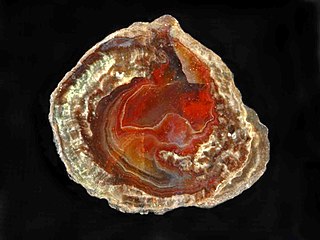 W
WA lithophysa is a felsic volcanic rock with a small spherulitic cavity and concentric chambers. Its shape is spherical or lenticular. These rocks are usually found within obsidian or rhyolite.
 W
WMafic is an adjective describing a silicate mineral or igneous rock that is rich in magnesium and iron. Most mafic minerals are dark in color, and common rock-forming mafic minerals include olivine, pyroxene, amphibole, and biotite. Common mafic rocks include basalt, diabase and gabbro. Mafic rocks often also contain calcium-rich varieties of plagioclase feldspar. Mafic materials can also be described as ferromagnesian.
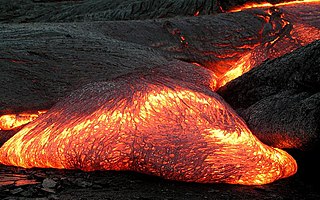 W
WMagma is the molten or semi-molten natural material from which all igneous rocks are formed. Magma is found beneath the surface of the Earth, and evidence of magmatism has also been discovered on other terrestrial planets and some natural satellites. Besides molten rock, magma may also contain suspended crystals and gas bubbles.
 W
WMagmatic underplating occurs when basaltic magmas are trapped during their rise to the surface at the Mohorovičić discontinuity or within the crust. Entrapment of magmas within the crust occurs due to the difference in relative densities between the rising magma and the surrounding rock. Magmatic underplating can be responsible for thickening of the crust when the magma cools. Geophysical seismic studies utilize the differences in densities to identify underplating that occurs at depth.
 W
WA melt inclusion is a small parcel or "blobs" of melt(s) that is entrapped by crystals growing in magma and eventually forming igneous rocks. In many respects it is analogous to a fluid inclusion within magmatic hydrothermal systems. Melt inclusions tend to be microscopic in size and can be analyzed for volatile contents that are used to interpret trapping pressures of the melt at depth.
 W
WNepheline syenite is a holocrystalline plutonic rock that consists largely of nepheline and alkali feldspar. The rocks are mostly pale colored, grey or pink, and in general appearance they are not unlike granites, but dark green varieties are also known. Phonolite is the fine-grained extrusive equivalent.
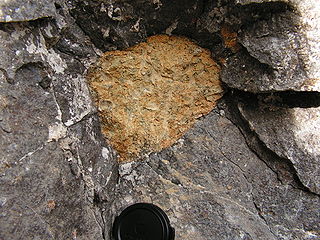 W
WNephelinite is a fine-grained or aphanitic igneous rock made up almost entirely of nepheline and clinopyroxene. If olivine is present, the rock may be classified as an olivine nephelinite. Nephelinite is dark in color and may resemble basalt in hand specimen. However, basalt consists mostly of clinopyroxene (augite) and calcic plagioclase.
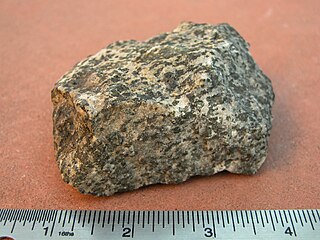 W
WNorite is a mafic intrusive igneous rock composed largely of the calcium-rich plagioclase labradorite, orthopyroxene, and olivine. The name norite is derived from Norge, the Norwegian name for Norway.
 W
WPeperino is an Italian name applied to a brown or grey volcanic tuff, containing fragments of basalt and limestone, with disseminated crystals of augite, mica, magnetite, leucite, and other similar minerals. The typical peperino occurs in the Alban Hills and in Soriano nel Cimino, near Rome, and was used by the ancients, under the name of lapis albanus, as a building stone and for the basins of fountains.
 W
WA phacolith is a pluton of igneous rock parallel to the bedding plane or foliation of folded country rock. More specifically, it is a typically lens-shaped pluton that occupies either the crest of an anticline or the trough of a syncline. In rare cases the body may extend as a sill from the crest of an anticline through the trough of an adjacent syncline, such that in cross section it has an S shape. In intensely folded terrain the hinge of folds would be areas of reduced pressure and thus potential sites for magma migration and emplacement.
 W
WPhonolite is an uncommon extrusive rock, of intermediate chemical composition between felsic and mafic, with texture ranging from aphanitic (fine-grain) to porphyritic. Its intrusive equivalent is nepheline syenite.
 W
WPoikilitic texture refers to igneous rocks where large later-formed less perfect crystals ('oikocrysts') surround smaller early-formed idiomorphic crystals ('chadacrysts') of other minerals. A poikilitic texture is most easily observed in petrographic thin sections.
 W
WA QAPF diagram is a double ternary diagram which is used to classify igneous rocks based on mineralogic composition. The acronym QAPF stands for "Quartz, Alkali feldspar, Plagioclase, Feldspathoid (Foid)". These are the mineral groups used for classification in QAPF diagram. Q, A, P and F percentages are normalized.
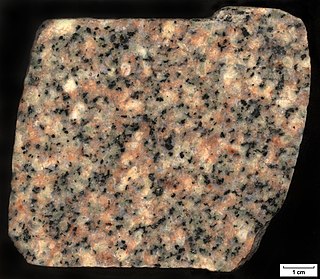 W
WQuartz monzonite or adamellite is an intrusive, felsic, igneous rock that has an approximately equal proportion of orthoclase and plagioclase feldspars. It is typically a light colored phaneritic (coarse-grained) to porphyritic granitic rock. The plagioclase is typically intermediate to sodic in composition, andesine to oligoclase. Quartz is present in significant amounts. Biotite and/or hornblende constitute the dark minerals. Because of its coloring, it is often confused with granite, but whereas granite contains more than 20% quartz, quartz monzonite is only 5–20% quartz. Rock with less than five percent quartz is classified as monzonite. A rock with more alkali feldspar is a syenite whereas one with more plagioclase is a quartz diorite. The fine grained volcanic rock equivalent of quartz monzonite is quartz latite.
 W
WA ring dike or ring dyke is an intrusive igneous body that is circular, oval or arcuate in plan and has steep contacts. While the widths of ring dikes differ, they can be up to several thousand meters. The most commonly accepted method of ring dike formation is directly related to collapse calderas.
 W
WSanukitoids are a variety of high-Mg granitoid found in convergent margin settings. The term "sanukitoid" was originally used to define a variety of Archean plutonic rock, but now also includes younger rocks with similar geochemical characteristics. They are called "sanukitoid" because of their similarity in bulk chemical composition to high-magnesium andesite from the Setouchi Peninsula of Japan, known as "sanukites" or "setouchites". Sanukite rocks are an andesite characterized by orthopyroxene as the mafic mineral, andesine as the plagioclase, and a glassy groundmass. Rocks formed by processes similar to those of sanukite may have compositions outside the sanukitoid field.
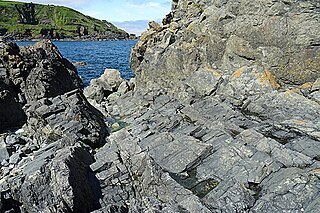 W
WA sheeted dyke complex, or sheeted dike complex, is a series of sub-parallel intrusions of igneous rock, forming a layer within the oceanic crust. At mid-ocean ridges, dykes are formed when magma beneath areas of tectonic plate divergence travels through a fracture in the earlier formed oceanic crust, feeding the lavas above and cooling below the seafloor forming upright columns of igneous rock. Magma continues to cool, as the existing seafloor moves away from the area of divergence, and additional magma is intruded and cools. In some tectonic settings slices of the oceanic crust are obducted (emplaced) upon continental crust, forming an ophiolite.
 W
WShonkinite is an intrusive igneous rock found in few places in the world. It is unique in having little silicates and large blocky crystals of black augite. It makes up much of the hard dark grey buttes of Montana that remain from the eroded rocks around the buttes.
 W
WStoping is a process accommodating the ascent of magmatic bodies from their sources in the mantle or lower crust to the surface. The theory was independently developed by Canadian geologist Reginald Aldworth Daly and American geologist Joseph Barrell.
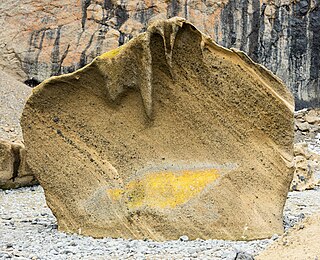 W
WTephra is fragmental material produced by a volcanic eruption regardless of composition, fragment size, or emplacement mechanism.
 W
WTrap rock, also known as either trapp or trap, is any dark-colored, fine-grained, non-granitic intrusive or extrusive igneous rock. Types of trap rock include basalt, peridotite, diabase, and gabbro. Trapp (trap) is also used to refer to flood (plateau) basalts, e.g. the Deccan Traps and Siberian Traps. The erosion of trap rock created by the stacking of successive lava flows often created a distinct stairstep landscape from which the term "trap" was derived from the Swedish word "trappa", which means "stairway".
 W
WMagmatic underplating occurs when basaltic magmas are trapped during their rise to the surface at the Mohorovičić discontinuity or within the crust. Entrapment of magmas within the crust occurs due to the difference in relative densities between the rising magma and the surrounding rock. Magmatic underplating can be responsible for thickening of the crust when the magma cools. Geophysical seismic studies utilize the differences in densities to identify underplating that occurs at depth.
 W
WVolcanic rock is a rock formed from lava erupted from a volcano. In other words, it differs from other igneous rock by being of volcanic origin. Like all rock types, the concept of volcanic rock is artificial, and in nature volcanic rocks grade into hypabyssal and metamorphic rocks and constitute an important element of some sediments and sedimentary rocks. For these reasons, in geology, volcanics and shallow hypabyssal rocks are not always treated as distinct. In the context of Precambrian shield geology, the term "volcanic" is often applied to what are strictly metavolcanic rocks. Volcanic rocks and sediment that form from magma erupted into the air are called "volcaniclastics," and these are technically sedimentary rocks.